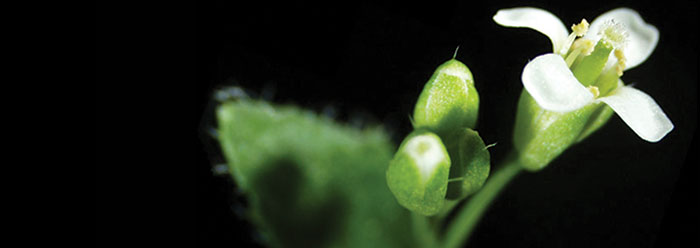Have you ever wondered how a plant knows when it’s time to flower? How does it know it needs to bloom and reproduce to perpetuate itself for future generations? Unlike animals, plants cannot get up and move around as a means to adjust to their environment. They have to respond to their surroundings, essentially, where they are planted. They need to have systems that sense and respond to important environmental signals such as day length, light quality, temperature, water availability, and even chemical signals emitted by other organisms.1, 2
We live in a world of seasonal fluctuations. When it comes to flowering and producing seed, timing is everything for a plant. In many climates, there are only certain times of the year when this process can occur effectively. Plants respond to both day length and temperature via an elaborate network of photoreceptors and temperature-sensing systems. These environmental response systems are further integrated into the complex internal interaction between plant hormones and carbohydrate (sugars and starches)-sensing networks.1, 2, 3
Spring’s longer days and warmer temperatures signal a variety of receptor proteins in the plants’ leaves.4 This process turns on a suite of flowering genes that produce proteins called “florigens.” These act as long-distance signals to the growing tips of the shoots, triggering flower formation.1, 2, 3
While scientists have made extensive progress in understanding the key factors and elements of the photoreceptor and hormone pathways and their roles in flowering, much less is known about the role that carbohydrates play in this process. Interestingly, recent research has shown that mutations in key genes that code for a variety of enzymes involved in sugar and starch metabolism affect a variety of developmental processes, including flowering.5 The emerging picture of bio-complexity in this field is incredible.
It is noteworthy that the carbohydrate-signaling and control system are not performed in isolation, but co-processed in complete integration with the photoreceptor, temperature, and hormone sensory signals. Amazingly, these complicated and integrated biochemical networks are deployed without the use of a central nervous system like those found in many animals.
The combination of various sensory communication and processing systems in plants, such as those involved in flowering, are a clear example of an all-or-nothing set of features. Plants would effectively fail to interface with their environment and survive if any one of these features was removed.
These new discoveries in plant biology are convincing testimonies to the intelligence of the powerful Creator who engineered these remarkable living systems. Scientific discovery increasingly exposes their complexity, which utterly defies traditional evolutionary dogma.
References
- Srikanth, A. and M. Schmid. 2011. Regulation of flowering time: all roads lead to Rome. Cellular and Molecular Life Sciences. 68 (12): 2013.
- Wigge, P. et al. 2005. Integration of Spatial and Temporal Information During Floral Induction in Arabidopsis. Science. 309 (5737): 1056-1059.
- Paul, M. et al. 2008. Trehalose metabolism and signaling. Annual Review Plant Biology. 59 (1): 417-441.
- In some plant species, this process is triggered by longer days and cooling temperatures in the late summer and early fall.
- Wahl, V. et al. 2013. Regulation of Flowering by Trehalose-6-Phosphate Signaling in Arabidopsis thaliana. Science. 339 (6120): 704-707.
* Dr. Tomkins is Research Associate at the Institute for Creation Research and received his Ph.D. in Genetics from Clemson University.
Cite this article: Tomkins, J. 2013. Complex Bioengineering in Blooming Flowers. Acts & Facts. 42 (4): 16.














